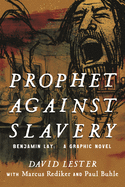
Benjamin Lay, small in stature with dwarfism, was a monumental historical figure almost lost until historian Marcus Rediker published The Fearless Benjamin Lay (2017), which returned Lay to prominence as "the first revolutionary abolitionist." Canadian artist David Lester energetically distills Rediker's biography into a dynamic graphic adaptation, Prophet Against Slavery, a testament to Lay's outspoken passion for human freedom.
Born into an English farming family in 1682, Lay became a working sailor at 21 and sailed the world for 12 years, which "allowed [him] to know mankind in all nations, colors and countries." He also witnessed the horrors of slavery. As a Quaker, he could not abide the hypocrisy of owning--then abusing, torturing, murdering--other human beings. His abhorrence played out in Quaker assemblies, where he theatrically underscored his denouncements with sword and pokeberry "blood." In England, in the New World--he eventually settled in Pennsylvania in 1732--he faced expulsion, but never stopped demanding liberation for all. Seventeen years after his death in 1759, the Quakers became the first group to abolish slavery within their communities.
Lester works in black, white and shades in between, his pages often pervaded by darkness, underscoring the images of suffering that permeated Lay's life. Lester's drawings vary from simple lines to intricately detailed, with an especially effective use of white and black space. His panels are unpredictable throughout, as if reflecting Lay's own nonconformist choices. "Almost three centuries later, we are still trying to get the poison and the venom--structural racism and its many injustices--out of the body politic," writes Rediker in an afterword. Even in the 21st century, Lay has much to teach contemporary audiences. --Terry Hong, Smithsonian BookDragon

